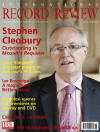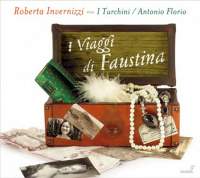Texte paru dans: / Appeared in:
*

International Record Review - (06/2013)
Pour
s'abonner / Subscription information
Glossa
GCD922606

8424562226067 (ID317)
Faustina Bordoni has achieved a lasting place in the history of opera through her association with two German composers: George Frideric Handel, from 1726-28 in London, and Johann Adolph Hasse, from 1730 in Milan and Venice, to the end of her life. From his Arminio (Milan, 1730) to her retirement in his Demofoonte (Dresden, 1748) she was his muse, and from their ‘matrimonio segreto’ (Venice, 1730) she was his wife. Together they proved a formidable international ‘love couple’, feted in the most important Italian operatic cities Venice, Naples, Florence, Milan — and in Dresden, where Hasse was court composer to the Catholic Saxon King, Augustus the Strong, and Faustina (she was always better known by her first name) was the prima donna assoluta of his opera company.
Unusually, this first volume in a new series of discs under the rubric ‘Sirene’ — Viaggi musicali di celebri cantante, charts Faustina’s travels without musical reference to either Handel or Hasse. By the time she came to London to launch her notorious rivalry with Handel’s incumbent prima donna, Francesca Cuzzoni, she already had a career of ten years behind her. She had made her debut at the age of 19 in her native Venice in Pollarolo’s Ariodante in 1716 and she was already one of Italy’s most famous female singers. An early role was Ermione in an opera by one of Handel’s later rivals, Bononcini, Astiannate (Venice, 1718), and it was in a London revival of this opera in 1727, probably with much new music, that she had her scandalous onstage fight with Cuzzoni in a performance attended by the Princess of Wales, engendering the legendary dispute of ‘The Rival Queens’, which John Gay lampooned in his 1728 satire The Beggar’s Opera.
In Roberta Invernizzi’s fascinating programme with Antonio Florio’s Turchini, we first meet Faustina chronologically though not in the track listing order as the titular heroine of Bononcini’s Rosiclea in Dania (actually the final item on the disc) in a rapt drawn-out lament, ‘Lasciami un soi momento’ of spellbinding beauty. This opera dates from the first of her two visits to Naples, where she was to assume a role for which she became famous: Rosmira in Domenico Sarros Partenope. It was during this period, prior to her meeting with Hasse, that she entranced another Neapolitan, Leonardo Vinci, who was so besotted with Faustina that he made his own version of the same text (the subject of Handel’s 1730 Partenope), retitling it Rosmira Fedele. When Faustina left Naples for the first time, Vinci wrote a cantata for her, known as La partenza di Faustina, in which the heroine Rosmira promises to come back within three years, unless death intervenes. A decade passed before she, now Signora Hasse, returned by which time the 40-year- old composer had been dead for two years. The recitative and aria, ‘Ecco mi parto, addio ... Qual ruscelletto che torna al mare’ (‘So now I am leaving, farewell … Like a stream returning to the sea’), is the touching product of Faustina’s and Vinci’s rapport and it is poignantly sung by Invernizzi here.
Indeed, Vinci looms larger than any of the other, mostly more obscure, composers featured here. ‘Scendi da questo soglio’ (‘Descend from this throne’) from the intriguingly titled Il Trionfo di Camilla (Parma, 1725) is a lively number revealing the sparkling and forceful Faustina characteristics that Handel was to exploit in the five roles he wrote specifically for her in London (and arias he wrote for her to sing in his revivals). Faustina clearly remembered Vinci with affection, for when she returned to Naples in 1732 she starred in the late composer’s Catone in Utica: Marzia’s ‘Confusa, smarrita’ (‘Confused and bewildered’) is another number exploiting Faustina’s brilliant coloratura and fiery temperament.
Although Faustina is now often described as a mezzo-soprano such a voice category did not exist in the eighteenth century when female and castrato voices were either sopranos or contraltos - none of the music written for her sounds too low for Insvernizzi’s bright high soprano. The Italian’s voice possibly lacks the expressive quality and range of colours required by two of the longest slow arias in her programme, Vinci’s superb ‘Un guardo solo ancor’ (‘Just one more glance’) — music which suggests the composer was deeply in love with his interpreter — from Il Trionfo di Camilla, arid Niccolo Porpora’s ‘Raggio arnica di speranza’ (‘Friendlv ray of hope’) from Poro (Turin, 1731).
One of the loveliest items on the disc, enchantingly sung in long-breathed, sensuous phrases by Invernizzi, is by a Neapolitan composer, Francesco Mancini, hitherto unknown to me: his ‘Canta e di cara usignolo’ (‘The dear nightingale sings and says’) from Traiano (Naples, 1723). It has a delectable obbligato for recorders, played by Rebecca Ferri and and Tomaso Rossi, soloist in Sarro’s Concerto for flute and strings, one of three attractive instrumental items — the others are the Sinfonias to Porpora’s Agrippina and Mancini’s Traiano — that serve as interludes to the vocal items.
In sum, this is another dic that will win friends for the stylish art of Invernizzi and buried treasure of the Italian Baroque. Giulia Veneziani’s eight-page booklet article vividly evokes Faustina and her world and there is a fascinating itinerary of the stops she made throughout her illustrious 32 -year career from Venice to Dresden by way of the most important operatic capitals of Europe.
Cliquez l'un ou l'autre
bouton pour découvrir bien d'autres critiques de CD
Click either button for many other reviews


